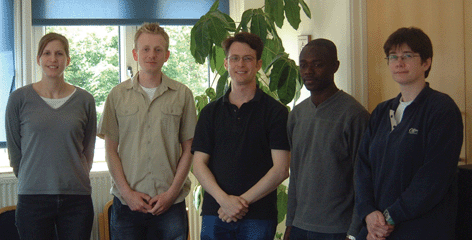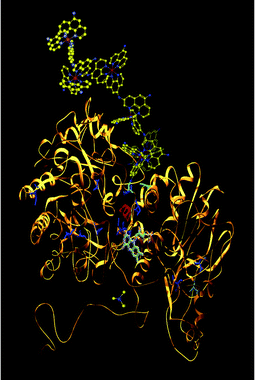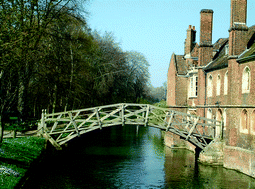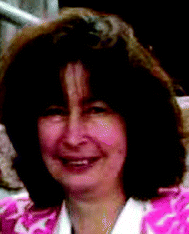Elizabeth A. H. Hall, University of Cambridge
Abstract
The Analystprofiles Lisa Hall, current member of (and the second generation of her family to serve on) the journal's Editorial Board. Recently awarded a personal chair in analytical biotechnology, she is the first ever female professor of Queens' College at the University of Cambridge.
Elizabeth (Lisa) Hall received her BSc and PhD in Chemistry from Queen Mary College, University of London in 1974 and 1977, respectively. She spent two years as a postdoctoral fellow in Laboratoire d'Electrochemie in Clermont, France and Institut für Organische Chemie, Johannes Gutenberg Universität, Mainz, before returning to Dr Bernard Dyer and Partners (analytical and consultant chemists) in 1980. In 1981 she was recruited by the Nuffield Department of Anaesthetics, University of Oxford to work on blood and anaesthetic gas sensors and in 1985 she was appointed as lecturer in the newly founded Biotechnology Centre of University of Cambridge. In 1999 she was promoted to Reader, and in 2003 she was appointed to a Chair in Analytical Biotechnology in the Institute of Biotechnology. Her book “Biosensors” (published by Open University and Wiley) was the first text book on biosensors to be targeted towards a treatment of an understanding of the underlying principles and has been the supporting text for undergraduates and graduates for many university courses.1 The core of Prof. Hall's research programme is found in biosensors and analytical systems, with a focus on investigating the details of mechanism and function. Her team have been successful in designing materials for novel detection structures and integrating optical and electrochemical transduction methods.What early influences encouraged you to take up science?
For as long as I can remember analytical science was my ambition. I imagine that it must have raised an adult smile to hear this serious 4–6 year old declare that she was going to be an analytical chemist, not a ballerina or a nurse or any of the other ambitions of little girls. There may have been some impact (genetic or environmental) in having a mother who had studied chemistry and a father who was a public analyst but, my memory is not of parental influence but sibling impact. With an elder brother that was talking of the ‘family business’, this was clearly the right thing for a 4 year old also to aim for!
I was lucky, I knew where my career was supposed to take me, but would I have chosen chemistry otherwise? I don't know. I don't think I found chemistry very inspirational as a school subject and we can see a contraction in students interested in chemistry and closure of some departments. Queen Mary College, University of London, where I studied as an undergraduate and where I first learned the trials and tribulations of research, will soon cease to provide anymore ‘green-fingered’ chemists. Is chemistry really ceasing in importance or is the image wrong? Is the subject too monochromatic or is the conduit between academic learning and the preparation for a wider spectrum of exciting modern careers the weak link? I discovered that it was fun in my school holidays when I worked in my father's laboratories analysing ‘suspect’ foods and drugs or unstuffing teddy bears and other toys to check the materials. If only we could shake off the lingering image of boring careers in a boring subject; it has provided me with cooking, construction, engineering, detective work, high tech ‘toys’ and lots of opportunity to create exciting solutions drawing on and combining knowledge from many sources.
How did you become interested in bioanalytical science in particular?After finishing my PhD, I ″took a couple of years off″ in France and Germany as a postdoc, specialising in mechanistic organic electrochemistry. However, the ‘family business’ was still in my veins and I returned to begin my apprenticeship in Dr Bernard Dyer and Partners in London, where I would work towards partnership and taking over from my father. It is interesting to note at this point that my father was also a member of The Analyst Editorial Board (or Publications Committee as it was then called) in the 1960’s when Attrill was the Editor. Quite out of the blue I received an invitation to the Nuffield Department of Anaesthetics in Oxford. I had not been looking for a position, but the temptation back into research was too great and I found myself entering the world of chemical sensors. In 1985 when I migrated to Cambridge, shortly after the establishment of the Biotechnology Initiative, I was able to seize the opportunity to explore analytical science with a greater ‘bio’ flavour. This was an exciting time: the biosensor field was still a ‘young area’ without the literature nearly saturated with report of yet another glucose biosensor and there was and is much to explore and conquer. The goal for the Institute has been uncompromising: to be a centre of excellence in Biotechnology, with an international reputation for highest quality research and innovation and I have sought to contribute to build the Institute and this goal.
You are regarded by many to be a great teacher and communicator. What do you view as the ingredients necessary to achieve this skill?I find it difficult to believe that dry dissemination and acquisition of scientific fact will excite anybody unless they can understand the context of that fact and the story that it tells. Some people do just memorise fact without emotion, but they miss out on that ‘eureka’ of understanding. In teaching or presenting our research, I try to work out how to tell a ‘story’ that I find exciting and I like my stories to be well illustrated. If I don't think that the subject is interesting, then the audience certainly won't either. Through years of running a charity for people with disabilities and working with people with learning difficulties (http://www.uphillskiclub.co.uk), I have seen that if you don't have an alternative way of communicating the message, there is a danger that the information will not be transmitted safely.
The knowledge required by research students often seems to fall into a no-mans land between text books and the frontiers of science. In order to maintain world leadership, it is important to provide our students (future leaders) in science and technology with a background and training of the highest academic standard and with an understanding and familiarity of business, commerce and ethics that will equip them for leadership and judgement in their future careers. Particularly in this age of globalisation, the ideal structure for achieving this portfolio is difficult to develop within a single department or even at a single institution due to a number of factors, but most significantly (i) intrinsic specialisation rarely fully supports multidisciplinarity, creating world leading research and training and (ii) each institution develops its own culture without the opportunities/benefits of across cultural experience, that lead to a more multifaceted development and approach. In the early 90s I initiated a “Eurocourse” scheme for analytical science and managed to persuade some of the principle experts in disciplines from engineering to biology from around Europe to give their time to intensive training weeks. The environment for exchange between the students themselves was as valuable as that between lecturer/student and I tried to underpin this by creating multidisciplinary, trans-national project groups, where expertise was pooled to solve set problems. Perhaps the most interesting spin-off has been seen when former students begin their own independent careers, with an international network of contacts already established from participation on the course. It is interesting that many have commented that this made a significant contribution to their early career.
 | ||
| Fig. 1 The Hall research group (L–R): Jessica Lamb, Simon Kew, Dr James Rooney, Charles Appiah-Kusi and Julie Saxton. | ||
There is no perfect answer to review procedures and we constantly need to question whether we are maintaining a high and fair standard, but let's not place the responsibility for scrutiny and quality just at the feet of the referees. The Editorial published in The Analyst by Mike Thompson2 asks authors to take responsibility for the quality and innovation reported in the research literature and it set a clear threshold for what should be presented for publication. We are all under pressure to maintain a high publication record, but unless we also endeavour to ensure that our papers make “a significant contribution to knowledge, originality and quality” we are responsible for a perpetuating glut of repetitive and sometimes inaccurate literature that will misinform and waste valuable research time of this and future generations. Clearly, we cannot ensure quality and integrity just by request to the authors and as discussed by Michael Freund,3 research is often a rather iterative process without clear quantum leaps in innovation, so that strict guidelines to referees for inclusion and exclusion are difficult. However, if the prestigious journals are not to become buried in a quagmire of mediocre research report, then the onus of justification for the innovation or importance of the iterative step must lie with the authors.
From the other side, I'm sure that most of us can recall referees comments that have seemed uninformed and unreasonable. My favourite rejection describing a new amperometric control regime for a biosensor was faulted because it “was so impractical for real use” and could “only have been devised in the Oxbridge ivory towers”. The referee's comments went on to lament our unworldly devotion to research. This same research is at the core of the innovation that founded a company now based in Boston, USA.
Some authors have also felt that strategic rejection occurs by some referees, which if true is a sad reflection of the self-confidence of the referee and not the author. It has been suggested that this problem could be overcome if referees were not anonymous. I would agree, but I also recognise that without anonymity we would at best currently have less detailed review and at worst be likely to propagate revenge and counter-revenge.
Tell us about some of your current research projects?It is clear that the chemistry and physics alone do not create the analysis, but that the dynamics of the whole system are an important part of the integrity of the analysis. Our work supports parallel streams of theoretical creation and evaluation of new optical formats for monitoring together with synthesis of analyte sensitive materials and experimental testing of new chemicals together with the investigation and manipulation of methods of transduction.
What are the things that excite me at present?
• Site directed mutagenesis of the amino acid sequence in a redox enzyme to create an analytical reagent with facilitated charge transfer for direct electrode-enzyme wiring.
• A biomimetic DNA (TNA) with anticipated wider use in drug discovery as well as analytical application.
• A ‘Fill and Flow’ palm held channel system for analysis, and its use in enzyme inhibition assay.
• A phasor transform of an electrochemical signal to deconvolve overlapping signals and allow multiple analyte measurement on a single electrode.
• An optical layer geometry that achieves full angle scan surface plasmon resonance or other enhanced reflectivity measurements at one incident angle for multiple analyte arrays.
• Fast Respirometry (Baroxymeter). A fundamental study of pressure–volume relationships due to respiration in a closed vessel, resulted in the design of a method for a 5 min test. This was previously considered impossible and is now making an impact in environmental ‘Direct Toxicity Assessment’.
• Synthesis of biomimetric ligands and molecules as analytical reagents in early risk monitoring of LDL-linked heart disease.
The observation that nature recruits a limited number of protein folds for building a variety of functions together with advancing protein engineering techniques now offer a unique opportunity to alter active site interactions to create enzymes having catalytic activity towards substrates with or without biological precedent. Entirely new activities could be engineered through rationale design and assembly to design redox proteins for substrates of analytical interest, thus building on the biosensor family. My research team have recently engineered an enzyme whose activity towards a substrate can be controlled by the potential applied to a molecular wire connecting enzyme and electrode, with site specific bonding. This introduces a new dimension for future design of stimulus response bioelectronics.
However, analytical reagents of biological and non-biological origin are becoming increasingly important and I enjoy the head on competition within my research group, between the mimetic and the genetically engineered, allowing the chemical and biological approaches to be researched alongside one another. Together with the burgeoning understanding of biomimetics, enabled through rationale design capability, comes the peptidomimetics and synzymes. These offer one component of an analytical reagent, but still require a transduction element. In a strategy where mimetic reagents are designed and synthesised, the conceptual leap to integration of the transducing core is a strong focus in our present work. Initial studies cloning ligand binding proteins for low density lipoprotein analysis in atherosclerosis risk monitoring, has expanded to the identification of peptide triads showing molecular recognition and the design of triad peptidomimetics. These will be united with synzyme redox cores or optical amplifying molecular systems in the next stage of this work, to achieve electrochemical or optical recognition/transduction scaffolds.
The route forward is very much based on these foundations. The need for design of the ‘whole’ analytical system must be at the fore. It is clear that a single achievement or single component does not create the measurement, but that the dynamics of the whole system are an important part of the integrity of the analysis. Increasing use must be emphasised of methods from biotechnology, engineering and synthesis, in combination with intelligent design in molecular actuation–transduction systems, selected by high throughput screening methods for analytical integrity and development. This is full of opportunity and excitement.
 | ||
| Fig. 2 Image shows site-directed mutagenesis of an enzyme to allow the charge transfer pathway to be extended outside the protein and connected with an electrode. This work was featured on the cover of the July 2003 issue of The Analyst. | ||
I still get excited when, having spent weeks or sometimes months pouring over data that we don't understand, searching adjacent disciplines for clues about interpretation and learning new principles, I can finally find a pattern and explain our results. These brain-twisters give me private pride but quite often they appear unexceptional once presented in a paper. Choosing the paper that gives me most pride is always updating since it reflects the achievements of individuals and my motivation for further discovery. The front cover feature in The Analyst in July 2003 describing our work on the site-directed mutagenesis of an enzyme to allow the charge transfer pathway to be extended outside the protein and connected with an electrode is presently high on the list.4 This work has been important for the PhD student, Claudia Loechel, who won a prize for her presentation at the RSC Analytical Research Forum meeting in 2001 and has together with other work on biomimics and virtual design algorithms had a pivotal influence on the further direction of our research for biosensors. Biosensors have focused on the use of the natural repertoire of biological recognition elements, but this work highlights the power of artificial design intervention and as described earlier, the integration of the analyte recognition process and the signal generation at the molecular level offer new opportunities.
You have been recently awarded a personal Chair at Cambridge. Give us an idea of your thoughts on this fine achievement at this stage in your careerOver the last 20 years I have often been asked why professorial appointments in Cambridge are so few so I feel very privileged to have been awarded this Chair. Of course, it also feels ‘special’ to be the first ever women professor of Queens’ College, Cambridge, but I am still learning and there are so many things that I ought to know. I remain in awe of the novelty and excellence I see around me. I have been especially fortunate in recruitment of outstanding students and postdoctoral researchers. With their ideas and collaboration, they have given me the opportunity to foster new interfaces of research and I hope that they feel that it is their work that has been recognised in this Chair in Analytical Biotechnology.
For more on research in the Hall group visit http://www.biot.cam.ac.uk/∼eah/
 | ||
| Fig. 3 Queen's College site sits astride the River Cam, the two halves joined across the river by the famous Mathematical Bridge — more correctly called The Wooden Bridge built in 1749 by James Essex the Younger to the design of William Etheridge. | ||
References
- E. A. H. Hall, Biosensors (Biotechnology Series), Wiley, 1991 Search PubMed.
- M. Thompson and G. Greenway, Analyst, 2002, 127, iii RSC.
- M. Freund, Analyst, 2004, 129, 283 RSC.
- C. Loechel, A. Basran, J. Basran, N. S. Scrutton and Elizabeth A. H. Hall, Analyst, 2003, 128, 889–898 RSC.
| This journal is © The Royal Society of Chemistry 2004 |

